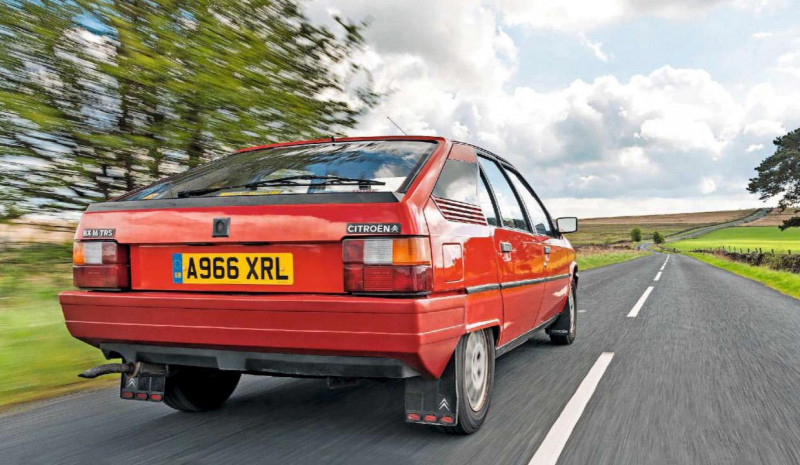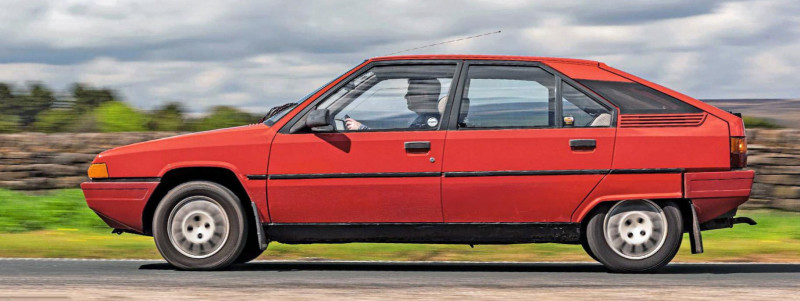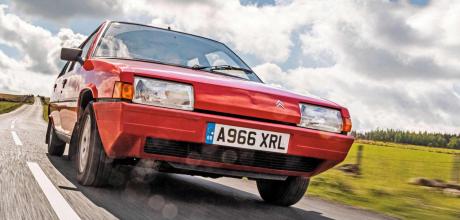1984 Citroën BX16 TRS
Once ubiquitous, now near-extinct, the BX is a hugely significant car that deserves to be remembered – and saved. Words Sam Dawson. Photography Jonathan Jacob.
Suburban Spacëcraft
Re-evaluating the unfairly overlooked, bargain-priced Citroën BX
Missed the DS boat? Why the BX is a big-Citroën bargain
Big Citroëns come with their own set of irritating clichés foisted upon them by those who don’t understand them. Unreliable, full of idiosyncratic technology that no oily-rag garage knows how to fix, and always falling short of their intended sales targets. Committed Citroënistés often seem to be a nervous bunch, keen to impress upon you their car’s unique abilities and style, yet often bruised by years dealing with automotive flat-Earthers.

And yet, as I sink into the soft, mattresslike drivers’ seat of this BX16 – the earliest roadworthy example left in England – I find myself remembering how familiar its unusual downward-hinging internal doorhandles once were to me. My parents didn’t even own a BX – it’s just that they were everywhere. Parents entertaining their kids would pretend to be pilots as they raised its hydropneumatic suspension from squat resting position to standard ride height. This wasn’t some oddball driven by a small bunch of eccentrics – it was the mainstream mass-market hydropneumatic breakthrough that Citroën had craved since the Fifties.
Citroën struggled to shift CXs, and the poor-selling XM threatened to axe the very concept of a large Citroën altogether but the company did a roaring trade in BXs, selling 2,315,739 from 1982 launch through to 1994 demise. In other words, comfortably more than the Vauxhall Cavalier. Now, just 343 BXs survive in the UK.

And yet the BX shares so many of those larger Citroëns’ endearingly unique traits. The sense of cabin airiness and space is aided by thin roof pillars. The dashboard is a wonderful piece of lateral-thinking modernism; effectively a CX-style revolving-drum binnacle evolved into the cubist Eighties but maintaining the ethos of fingertip control including a rocker switch for the indicators and sliders for the headlights and wiper controls. Marcello Gandini’s exterior styling carries all the crucial big-Citroën cues too – smooth grilleless nose, bullet profile, partially boarded-up rear wheels.
The brake pedal may look like a conventional top-hinged pendant but it’s classically Citroën again – negligible travel, just needing a caress to operate and sending feedback coursing into the sole of my right foot. The power-assisted steering is beautifully smooth, again reminiscent of the CX, and all part of a complex central hydropneumatic network crucial to a big-Citroën driving experience. The gear lever doesn’t hiss-click around the gate as it does in a DS, but is so beautifully lightweight and smooth in its action as to deliberately mimick it. The drive is so uncannily like that of the DS and CX that it makes me wonder why the BX is now so scarce and overlooked by even the classic Citroën fraternity.
The answer may lie in its corporate origins. The BX was launched in the UK with an advertising campaign that annoyed the repair sector and irritated long-term marque enthusiasts. The ‘Loves Driving, Hates Garages’ tagline was supposed to address the reputation for unreliability that Citroëns had accrued with the CX and GS, but some felt it made the BX seem mechanic-unfriendly.
It also enraged Citroënistés because it signalled a changing of the guard. The BX was the first Citroën to be fully engineered under new Peugeot-led PSA ownership, which had torn up a Robert Opron proposal in favour of facelessly directing the BX project from Paris, calling on Citroën’s engineers as and when needed. It featured Peugeot engines and gearboxes, conventional MacPherson struts interacting with Citroën’s famous oleopneumatic spheres and a chassis that was later shared with the Peugeot 405. Marcello Gandini’s styling still looked like nothing other than a Citroën but had evolved via Bertone concepts for Reliant and Volvo. It felt as though PSA was trying to disassociate itself from the intelligent, unique design and engineering approach that Citroën used to stand for and move the marque closer to Peugeot’s more conventional ethos. And yet not only did this approach seduce buyers who hadn’t considered a Citroën before, it also left Citroën’s formula undiluted. Out of curiosity I park up and get into the back of the idling BX.
The rear suspension dips briefly as I climb in then rises again to keep the car level. The hydropneumatic system also increases brake pressure in response to heavier loads in the boot in anticipation of needing to reel in more mass. The plastic bonnet, valances and tailgate serve to keep the kerbweight of a basic BX down to a flyweight 870kg as well as making the panels most likely to be stone-chipped completely rust-proof.
Back in the front seat, the BX reminds me why it was such a devastating market force that Citroën could have only dreamed of in the pre-PSA years. Peugeot parts-sharing made it cheaper to build and a combination of a 0.34 drag coefficient and Lotus-like weight meant that it didn’t take much to propel it. The basic 1.1-litre model cost £5198, making it a direct Ford Escort Popular rival. And yet it rode like a luxury saloon, breached the 50mpg barrier on a cruise and boasted a cavernous interior more akin to a Sierra’s. This 1.6 isn’t fast against a stopwatch but nippy and light on its feet like a supermini. It doesn’t roll heavily in corners like hydropneumatic Citroëns of old either. And yet that cushion of air it rides on means it never feels stiffly sprung. Nudge the single-spoke wheel into a tight bend and it finds its cornering attitude swiftly then commits to a gliding motion. In recent years we’ve allowed the presence of electronics to be mistaken for progress and mask uninspiring engineering in family cars. By contrast, there’s not one element of the way that this near-40-year-old mass-market family-wagon drives that could be labelled crude or unsophisticated, even today.
As an engineering package, the BX was hugely adaptable compared to conventional rivals from Ford or Vauxhall and Peugeot’s dated 305. It became the biggest seller in its class in 19RD diesel form and beloved of caravanners. With the 205 GTi 1.9 engine fitted then tweaked further with a 16-valve cylinder head, its 160bhp and 135mph potential made it a hot hatch that was as quick as its big-brother CX GTi Turbo and outpaced the Ford Escort RS Turbo. And yet it’s in comfort-spec TRS form, as here, that the BX really excels. Because any car can be turned into a diesel loadlugger or a fire-breathing hot hatch with a change of engine, but mass-produced family hatchbacks rarely convince as luxury cars.
When new, this 16 TRS cost £6909, undercutting the £7331 Ford Escort 1.6 Ghia. And yet while the Ford offered velour trim, a fancy stereo and upgraded soundproofing by way of luxury, the BX’s ride quality and cossetting seat design is in another realm of sophistication. Suspension that Rolls- Royce previously used for its Silver Shadow and which only Jaguar managed to rival using conventional technology, gives the BX a gliding ride that turns potholes into dimples. Its airy roominess seems extravagant for its class, making the Ghia’s superficial plushness seem like an insult to the buyer’s intelligence.
It doesn’t need the Ghia’s soundproofing either; its light weight leaves the engine understressed and aerodynamics make it quiet too. Accelerating across the North York Moors today elicits a rush of air over the BX in the manner of a glider diving into a thermal rather than whistling wind snagging on rain gutters and poorly designed door frames. I think that the BX has been cruelly overlooked for too long. Regard it as an alternative to a CX or even a late ID or D Super and it starts to look like staggering value. PSA X-series engines are long-lived and simple yet smoother-revving than anything Citroën offered before; gearboxes less complicated; bodies less rot-prone as long as the basic sill and scuttle structure is sound.
However, the BX also exists in a stylistic and engineering sweet spot; it benefits from PSA’s guiding hand yet still belongs to a resolutely Citroën era of single-spoke steering wheels, mono wipers, rear spats and suspension that sinks the car to the ground like a settling hovercraft when the engine is switched off. Its Xantia successor may have been mechanically clever but it looked boringly conventional inside and out by contrast. With DSs firmly commanding upwards of £15k and nice CXs following them, it’s good to know that you can still buy something extremely similar in feel for less than £5000.
1984 Citroën BX16 TRS
- Engine 1580cc transverse four-cylinder, ohc, Weber 32DRTC carburettor
- Max Power 93bhp @ 6000rpm
- Max Torque 101lb ft @ 3250rpm
- Transmission Five-speed manual, front-wheel drive
- Suspension
- Front: independent, MacPherson struts, hydropneumatic spheres, anti-roll bar
- Rear: independent, trailing arms, hydropneumatic spheres
- Brakes Servoassisted discs front and rear
- Weight 870kg (1918lb)
- Performance 0-60mph: 11.3sec
- Top speed: 109mph
- Cost new £6909
- Classic Cars Price Guide £5000
Bizarre switchgear majors on the cool factor rather than useful ergonomics.Central lever controls the ride height – just like on a Fifties DS.0.34 drag coefficient makes the BX a quiet and comfortable cruiser. Design cues from the DS and CX are all here, right down to the single-spoke wheel.
No mistaking Gandini’s teardrop design as being anything other than a Citroën. Low kerbweight means understressed four-cylinde engine feels quite nippy. Ride quality, seat design and airiness made rivals’ attempts at refinement look banal. Pleasing Cubist design touches were lost on later plain-Jane Xantia.
‘This wasn’t some oddball – it was the breakthrough that Citroën had craved’
OWNING A CITROËN BX
‘My parents had a Citroën BX when I was a kid – as soon as they replaced it with a conventionallysprung ZX I used to get car-sick!’ says Phil Greave, owner of this BX16 TRS. ‘This one came up for sale as an £850 restoration project needing a lot of work at the time I was graduating from university, and I managed to persuade my parents to buy it for me as a present.
‘I’ve had it restored – it’s cost in excess of £4000. The mechanical bits are easy to come by, but other parts availability is a real issue nowadays. This interior is a replacement because the original had suffered very badly from ultraviolet damage, and it was a case of taking what’s available — trim and switchgear is near-impossible to find outside of French scrapyards, and it’s brittle too. It’s a similar story with body panels – pattern parts often don’t fit and you can’t just find a spare door in a scrapyard any more. Galvanisation was good for the era and the use of plastic panels helps, but once they start rotting in the scuttle and floors they’ve had it. If you lift the carpets on some rusty examples you’ll see daylight underneath.
‘Prices are on the up now, as the 16v GTis ride the Eighties hot hatch boom. But this is pulling more ordinary BXs up behind them – they’re getting restored now. They’re great GTs – my parents used to drive theirs down to the south of France, and I’ve taken mine to Holland for Citroën shows.’


